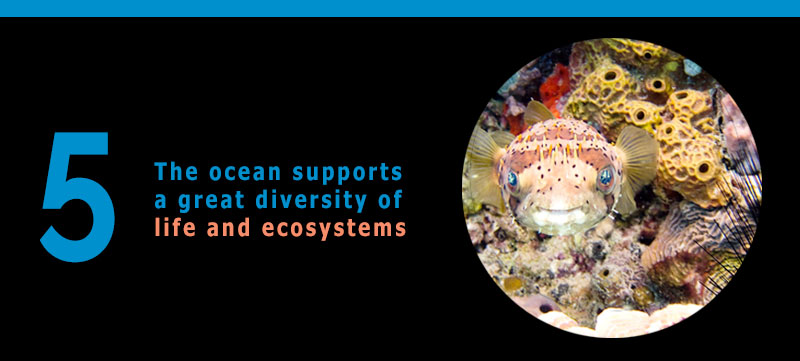
For the next three weeks we are discussing the concept of Ocean Literacy. In a series of premises defined by educators as fundamental to our understanding of ocean systems is the following:
The ocean supports a great diversity of life and ecosystems
The ocean is an astonishingly rich and fertile place at every level: micro to macro. Infinite bits and pieces are simultaneously organized into relationships, processes, and amplified systems that are in constant movement of generation and re-generation, life and death, life again, and life again, that is dynamic beyond our present knowledge, perhaps our imagination.
How is such a phenomenon to be observed and understood? How can science even begin to access, collect, analyze, and conclude such a vast work and world of seemingly infinite change?
Several ideas come to mind.
One way to understand the ocean is to enumerate its component parts. And that is precisely what science does today, with a global network of observation stations, buoys, autonomous vehicles, satellites, and research vessels with underwater instruments for exploration and discovery. The old adage that we know more about Mars that we do the ocean is changing. Yes, Mars has its exciting aspects and intimations, but knowledge of the the ocean as a physical, geological, chemical, and biological space is accelerating exponentially, driven by expanding technology, the power of curiosity and revelation, and a growing sector of the public that wants to see and know what’s out there and how it pertains to our living in so many ways. In my informal anecdotal poll of career aspirations among the young, Astronaut have been handily replaced by Oceanographer or Marine Scientist, an encouraging sign for the future of ocean exploration.
Another way to understand the ocean is to reduce its vastness to manageable elements such as marine protected areas, whereby large parts of the ocean map are designated for restricted use and safety from extraction and polluting activities at risk. A similar method is the partition of the total fecundity into definable species of flora or fauna that can be studied horizontally across a migration path or food chain or life cycle that relies on the efficiency and economy of specialization. And yet another method is to focus on the whole, not so much as a sum of parts, but rather as an arrangement of connections that run off energy generated from outside or inside the ecosystem, viewed as an entity in and of itself and interacting with other system of similar composition and scale.
A third way toward understanding is, of course, the amalgam of these two as affected by human responses in the form of utility and additional layers of social interaction as defined by finance, community, and culture. The complexity of the ocean system is further complicated by human applications and interactions, comparably organic, fraught with possibility, fraught with pain. Human life is but a part of ocean life. An ecosystem relates biological organisms to one another and their physical surroundings, just as it is political entity that seeks to protect its value from all forms of pollution.
Finally, there is a fourth way to understand, by the negative value of the deprivation of diversity and life, activities that consume species to extinction, degrade habitats to dead zones, poison the sustaining cycles of food and food chain, modify or destroy the genetic cycle, and deprive all participants in the ocean world of succeeding parts of its total fecundity, its implication for global health, a process of subtraction of value until the other ways of understanding are subverted, compromised, and left for dead. It will take more than a generation of aspiring marine scientists and ocean explorers to protect us from this destructive regress.
So what will it be? A process of addition, or subtraction, in an ocean account book of ecosystems and diversity? Ours to choose. A future that is ours to gain or lose.
- - -
PETER NEILL is founder and director of the World Ocean Observatory and is author of “The Once and Future Ocean: Notes Toward a New Hydraulic Society.” He is also the host of World Ocean Radio, a weekly podcast addressing ocean issues, upon which this blog is inspired.
Other episodes in the Ocean Literacy series:
< 01: An Introduction
< 02: One Big Ocean
< 03: Ocean Shapes the Features of Earth
< 04: Weather and Climate
< 05: Ocean Made Earth Habitable


